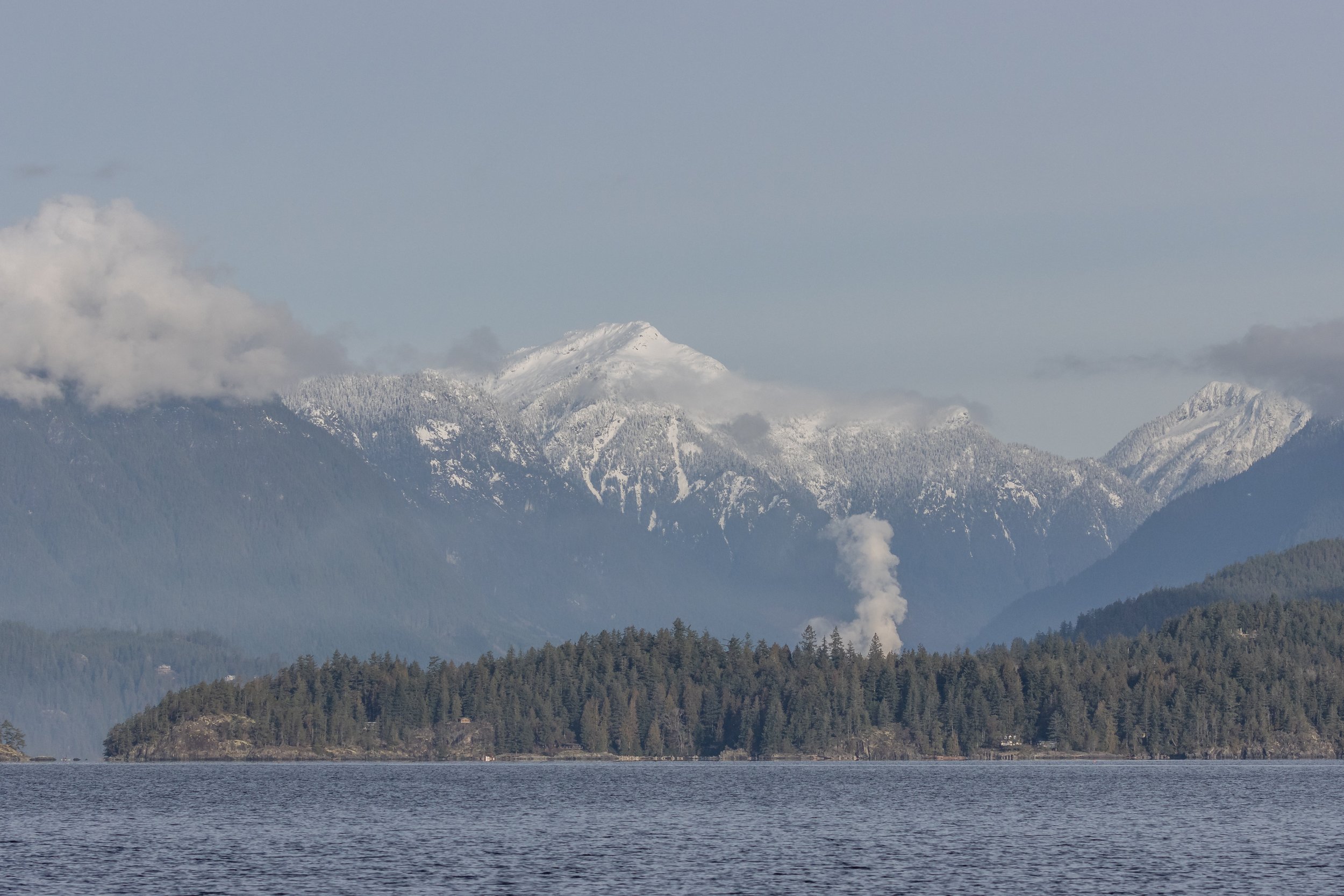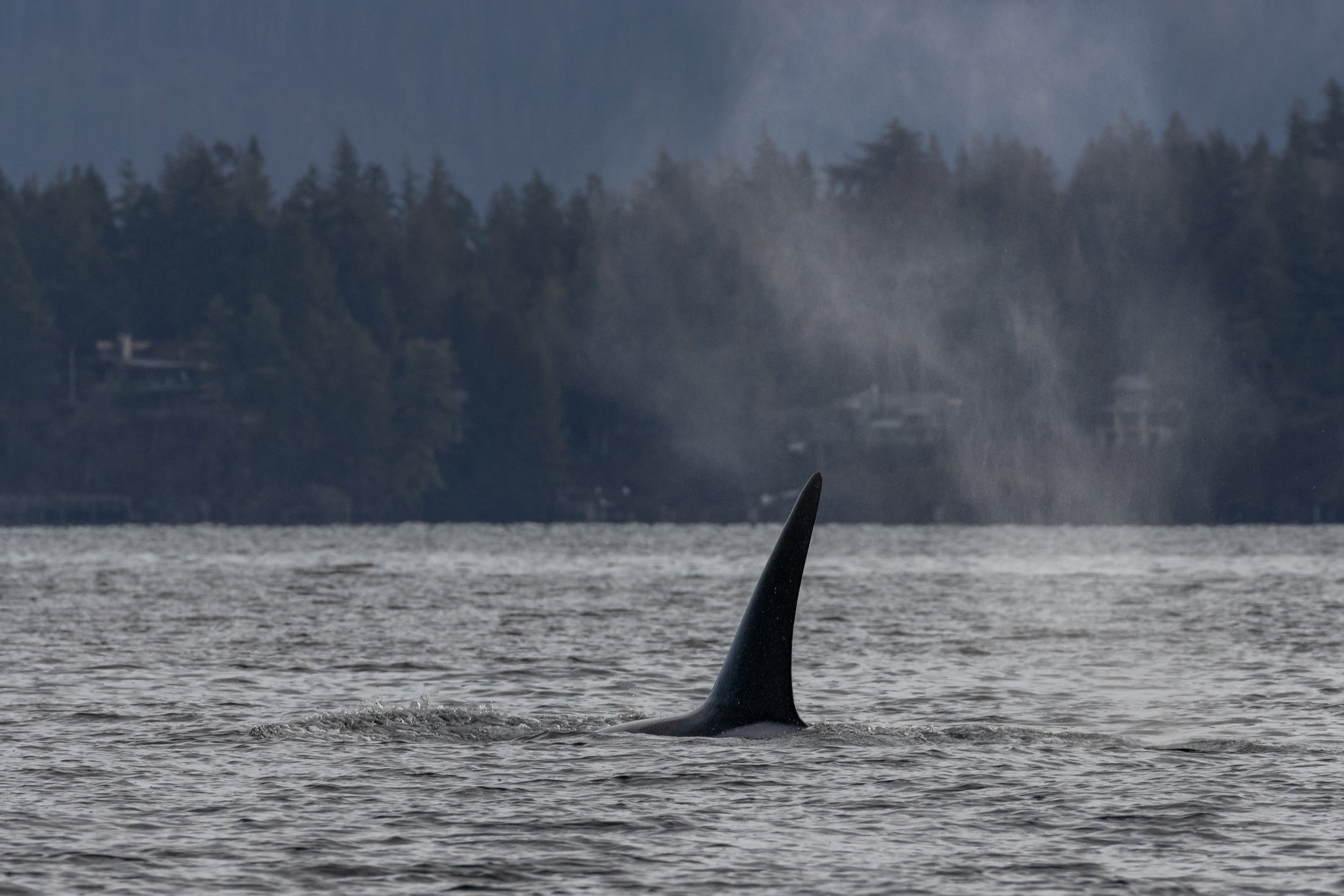February 8, 2023 - First Tour of the year with the T090s!
Although we know that there have been lots of whales around in January this year, we hadn’t had enough people wanting to brave the colder weather to get out and find them, that is until now! We had a early charter who wanted to get out and explore the unique ecosystem of the Salish Sea, we so headed over to Vancouver to pick them up and headed into Howe Sound to see what we could find! It didn't take long before we spotted something in the distance! It was a large black triangle cutting through the water, surrounded by little clouds of mist…ORCA!
We slowly approached the animals, and starting getting some good looks at them, and were able to identify them as the T090s! The T090s consist of the following members:
T090 Eagle (1980)
T090B Piglet (2006)
T090C Tigger (2010)
T090D Kanga (2017)
Our crew also swore they saw a second male while approaching, but they never showed up in the photos so it’ll remain a mystery!
Today the pod was travelling north deeper into Howe Sound. Howe Sound is one of our favourite places to see whales, since the landscape is breathtaking! It is a glacial fjord, so it has tall, rocky shorelines and the coastal mountains hug the sound, making them tower over the boat as you travel through the area. This time of year the snowy peaks provide a great contrast against the lush green of the forest.
Getting to see orca in this environment is always breathtaking. Since we watch them in their natural habitat we are lucky enough to get a glimpse into their everyday life. Most of the time we spend observing orca they will be acting like we saw them today, slowly travelling and conserving energy until they get to their next meal or meet up for a T-party. Howe Sound has no shortage of snacks for the transient orca, with many seal haul outs along the rocky islands and even some sea lions around in the fall/winter/spring. With four members in the pod, this pod will need to eat about 2,000 pounds of food everyday, since the average per whale is 500 pounds. Each Harbour Seal, which is their main food source, weighs about 300 pounds, so that’s a total of about 7 seals a day. When the orca hunt, it can be a swift end to their meal, or sometimes it can take a much longer. Usually this is dependant on what they are hunting, since something like a Steller Sea Lion is much larger and takes more care to ensure the whales also don’t get injured in the hunt. Even if we over estimate the time taken to successfully finish each hunt, say an hour, that’s only 7 hours in their day. The rest of that time get filled by travel, socialization, and sleep. I’m sure there’s other things in their day as well, but let’s keep it simple. So when we see them for an hour out of the day you never really know what you might get to see!
The T090’s continued their travels North, and eventually our hour with them was up, so we headed out in search of other wildlife. We headed out of Howe Sound, into the Strait of Georgia to stop at the White Islets. This is another geologically beautiful place, with tall white rock protruding out of the water. These rocks attract Steller Sea Lions who like to perch at the top, fighting amongst themselves or taking a nap. We commonly see them diving from the tall rocks into the deep water below. On the shorter shelves closer to the waterline we also caught glimpse of some Harbour Seals hauled out. The smaller, spotted pinnipeds don’t have the same dexterity that the sea lions do on land, so they aren’t typically found in the higher, steeper rocks. Instead these seals were relaxing on the rocks, away from their Sea Lion cousins.
We spent some more time exploring the area around Vancouver before our time was officially up and we headed back into the harbour. It was great to get back on the water and we are so happy to have been able to see the T090s and all the other wildlife and sights! All the photos from the day were taken by Marine Naturalist Vanessa Vereschahen, and you can see them below!
A large group of Surf Scoters.
Something must have startled them!
The coastal mountains around Howe Sound.
Another beautiful look at the mountains.
T090B Piglet surfacing. You can clearly his eye patch, dorsal fin, and saddle patch in this photo! Not often you get all three IDing features in one picture.
Another slowly mountain peak.
T090D Kanga preparing to dive.
T090C Tigger! She has a very pointed dorsal fin compared to the rest of her family.
T090B Piglet.
T090C Tigger. Notice the rocky shoreline in the background.
The Matriarch, T090 Eagle!
T090 Eagle has this lump of scar tissue near the base of her dorsal fin which can be used as an additional ID feature.
T090 Eagle.
T090D Kanga surfacing in front of her mom, T090 Eagle.
T090B Piglet with the tips of his family’s dorsal fins behind him.
T090B Piglet.
A bunch of Steller Sea Lions on the White Islets.
This is at high tide, there’s even more steep rocks at low!
A couple of the Harbour Seals hauled out on the islets.
A very vocal Steller Sea Lion to say goodbye!




















